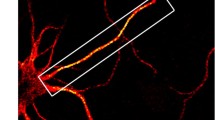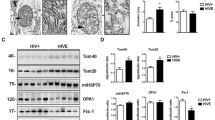Abstract
Human immunodeficiency virus (HIV) does not infect neurons, yet dendritic simplifications and loss of synapses are seen in different brain areas of people living with HIV. Nevertheless, the underlying causes of the pathological alterations observed in these individuals are poorly comprehended. HIV interactions with cells of the central nervous system occur through viral proteins, including gp120 and Tat. These proteins exhibit a potent neurotoxic effect on synapses. This chapter will briefly present new emerging concepts that link the ability of viral proteins to promote the degeneration of synapses by damaging the neuronal cytoskeleton.
Access this chapter
Tax calculation will be finalised at checkout
Purchases are for personal use only
Similar content being viewed by others
Abbreviations
- AIDS:
-
Acquired immunodeficiency syndrome
- ANI:
-
Asymptomatic neurocognitive impairment
- BBB:
-
Blood-brain barrier
- BDNF:
-
Brain-derived neurotrophic factor
- cART:
-
Combination antiretroviral therapy
- CNS:
-
Central nervous system
- CSF:
-
Cerebrospinal fluid
- Gag:
-
Group-specific antigen
- HAND:
-
HIV-associated neurocognitive disorder
- HIV:
-
Human immunodeficiency virus-1
- LTR:
-
Long terminal repeat
- MAP 2:
-
MT-associated protein 2
- MND:
-
Mild neurocognitive disorder
- MTs:
-
Microtubules
- Nef:
-
Negative regulating factor
- NFs:
-
Neurofilaments
- PLH:
-
People living with HIV
- PTMs:
-
Posttranslational modifications
- Rev.:
-
RNA splicing-regulator
- Tat:
-
Transactivator of transcription
- TUBB3:
-
Class III beta tubulin
- Vif:
-
Viral infectivity factor
- Vpr:
-
Viral protein R
- Vpu:
-
Viral protein U
References
Avdoshina, V., Caragher, S. P., Wenzel, E. D., Taraballi, F., Mocchetti, I., & Harry, G. J. (2017). The viral protein gp120 decreases the acetylation of neuronal tubulin: Potential mechanism of neurotoxicity. Journal of Neurochemistry, 141, 606–613. https://doi.org/10.1111/jnc.14015
Avdoshina, V., Fields, J. A., Castellano, P., Dedoni, S., Palchik, G., Trejo, M., Adame, A., Rockenstein, E., Eugenin, E., Masliah, E., & Mocchetti, I. (2016). The HIV Protein gp120 alters mitochondrial dynamics in neurons. Neurotoxicity Research, 29, 583–593. https://doi.org/10.1007/s12640-016-9608-6
Avdoshina, V., Mahoney, M., Gilmore, S. F., Wenzel, E. D., Anderson, A., Letendre, S. L., Imamichi, T., Fischer, N. O., & Mocchetti, I. (2020). HIV influences microtubule associated protein-2: Potential marker of HIV-associated neurocognitive disorders. AIDS, 34, 979–988. https://doi.org/10.1097/QAD.0000000000002509
Avdoshina, V., Taraballi, F., Dedoni, S., Corbo, C., Paige, M., Saygideger Kont, Y., Uren, A., Tasciotti, E., & Mocchetti, I. (2016). Identification of a binding site of the human immunodeficiency virus envelope protein gp120 to neuronal-specific tubulin. Journal of Neurochemistry, 137, 287–298. https://doi.org/10.1111/jnc.13557
Bachis, A., Major, E. O., & Mocchetti, I. (2003). Brain-derived neurotrophic factor inhibits human immunodeficiency virus-1/gp120-mediated cerebellar granule cell death by preventing gp120 internalization. The Journal of Neuroscience, 23, 5715–5722.
Baird, F. J., & Bennett, C. L. (2013). Microtubule defects & neurodegeneration. Journal of Genetic Syndromes and Gene Therapy, 4, 203. https://doi.org/10.4172/2157-7412.1000203
Berth, S., Caicedo, H. H., Sarma, T., Morfini, G., & Brady, S. T. (2015). Internalization and axonal transport of the HIV glycoprotein gp120. ASN Neuro, 7. https://doi.org/10.1177/1759091414568186
Binder, L. I., Frankfurter, A., & Rebhun, L. I. (1985). The distribution of tau in the mammalian central nervous system. The Journal of Cell Biology, 101, 1371–1378.
Bruce-Keller, A. J., Chauhan, A., Dimayuga, F. O., Gee, J., Keller, J. N., & Nath, A. (2003). Synaptic transport of human immunodeficiency virus-Tat protein causes neurotoxicity and gliosis in rat brain. The Journal of Neuroscience, 23, 8417–8422.
Butler, T. R., Smith, K. J., Self, R. L., Braden, B. B., & Prendergast, M. A. (2011). Neurodegenerative effects of recombinant HIV-1 Tat(1-86) are associated with inhibition of microtubule formation and oxidative stress-related reductions in microtubule-associated protein-2(a,b). Neurochemical Research, 36, 819–828. https://doi.org/10.1007/s11064-011-0409-2
Cambray-Deakin, M. A., & Burgoyne, R. D. (1987). Posttranslational modifications of alpha-tubulin: Acetylated and detyrosinated forms in axons of rat cerebellum. The Journal of Cell Biology, 104, 1569–1574.
Cartelli, D., Ronchi, C., Maggioni, M. G., Rodighiero, S., Giavini, E., & Cappelletti, G. (2010). Microtubule dysfunction precedes transport impairment and mitochondria damage in MPP+ −induced neurodegeneration. Journal of Neurochemistry, 115, 247–258. https://doi.org/10.1111/j.1471-4159.2010.06924.x
Coles, C. H., & Bradke, F. (2015). Coordinating neuronal actin-microtubule dynamics. Current Biology, 25, R677–R691. https://doi.org/10.1016/j.cub.2015.06.020
Dehmelt, L., & Halpain, S. (2005). The MAP 2/Tau family of microtubule-associated proteins. Genome Biology, 6, 204. https://doi.org/10.1186/gb-2004-6-1-204
Del Valle, L., Croul, S., Morgello, S., Amini, S., Rappaport, J., & Khalili, K. (2000). Detection of HIV-1 Tat and JCV capsid protein, VP1, in AIDS brain with progressive multifocal leukoencephalopathy. Journal of Neurovirology, 6, 221–228.
Dixit, R., Ross, J. L., Goldman, Y. E., & Holzbaur, E. L. (2008). Differential regulation of dynein and kinesin motor proteins by tau. Science, 319, 1086–1089. https://doi.org/10.1126/science.1152993
Ensoli, B., Buonaguro, L., Barillari, G., Fiorelli, V., Gendelman, R., Morgan, R. A., Wingfield, P., & Gallo, R. C. (1993). Release, uptake, and effects of extracellular human immunodeficiency virus type 1 Tat protein on cell growth and viral transactivation. Journal of Virology, 67, 277–287.
Eugenin, E. A., Clements, J. E., Zink, M. C., & Berman, J. W. (2011). Human immunodeficiency virus infection of human astrocytes disrupts blood-brain barrier integrity by a gap junction-dependent mechanism. The Journal of Neuroscience, 31, 9456–9465. 31/26/9456 [pii]. https://doi.org/10.1523/JNEUROSCI.1460-11.2011
Eugenin, E. A., King, J. E., Nath, A., Calderon, T. M., Zukin, R. S., Bennett, M. V. L., & Berman, J. W. (2007). HIV-tat induces formation of an LRP-PSD-95-NMDAR-nNOS complex that promotes apoptosis in neurons and astrocytes. Proceedings of the National Academy of Sciences of the United States of America, 104, 3438–3443. https://doi.org/10.1073/pnas.0611699104
Fulga, T. A., Elson-Schwab, I., Khurana, V., Steinhilb, M. L., Spires, T. L., Hyman, B. T., & Feany, M. B. (2007). Abnormal bundling and accumulation of F-actin mediates tau-induced neuronal degeneration in vivo. Nature Cell Biology, 9, 139–148. https://doi.org/10.1038/ncb1528
Gelman, B. B. (2015). Neuropathology of HAND with suppressive antiretroviral therapy: Encephalitis and neurodegeneration reconsidered. Current HIV/AIDS Reports, 12, 272–279. https://doi.org/10.1007/s11904-015-0266-8
Hategan, A., Bianchet, M. A., Steiner, J., Karnaukhova, E., Masliah, E., Fields, A., Lee, M. H., Dickens, A. M., Haughey, N., Dimitriadis, E. K., & Nath, A. (2017). HIV Tat protein and amyloid-beta peptide form multifibrillar structures that cause neurotoxicity. Nature Structural & Molecular Biology, 24, 379–386. https://doi.org/10.1038/nsmb.3379
Haughey, N. J., Nath, A., Mattson, M. P., Slevin, J. T., & Geiger, J. D. (2001). HIV-1 Tat through phosphorylation of NMDA receptors potentiates glutamate excitotoxicity. Journal of Neurochemistry, 78, 457–467.
Hirokawa, N., Shiomura, Y., & Okabe, S. (1988). Tau proteins: The molecular structure and mode of binding on microtubules. The Journal of Cell Biology, 107, 1449–1459.
Huang, Y., Paxton, W. A., Wolinsky, S. M., Neumann, A. U., Zhang, L., He, T., Kang, S., Ceradini, D., Jin, Z., Yazdanbakhsh, K., Kunstman, K., Erickson, D., Dragon, E., Landau, N. R., Phair, J., Ho, D. D., & Koup, R. A. (1996). The role of a mutant CCR5 allele in HIV-1 transmission and disease progression. Nature Medicine, 2, 1240–1243.
Hubbert, C., Guardiola, A., Shao, R., Kawaguchi, Y., Ito, A., Nixon, A., Yoshida, M., Wang, X. F., & Yao, T. P. (2002). HDAC6 is a microtubule-associated deacetylase. Nature, 417, 455–458. https://doi.org/10.1038/417455a
Johnson, T. P., & Nath, A. (2016). Protocol for detection of HIV-Tat protein in cerebrospinal fluid by a Sandwich Enzyme-linked immunosorbent assay. Methods in Molecular Biology, 1354, 343–352. https://doi.org/10.1007/978-1-4939-3046-3_23
Khalil, M., Teunissen, C. E., Otto, M., Piehl, F., Sormani, M. P., Gattringer, T., Barro, C., Kappos, L., Comabella, M., Fazekas, F., Petzold, A., Blennow, K., Zetterberg, H., & Kuhle, J. (2018). Neurofilaments as biomarkers in neurological disorders. Nature Reviews. Neurology. https://doi.org/10.1038/s41582-018-0058-z
Lewis, S. A., Wang, D. H., & Cowan, N. J. (1988). Microtubule-associated protein MAP 2 shares a microtubule binding motif with tau protein. Science, 242, 936–939.
Li, W., Li, G., Steiner, J., & Nath, A. (2009). Role of Tat protein in HIV neuropathogenesis. Neurotoxicity Research, 16, 205–220. https://doi.org/10.1007/s12640-009-9047-8
Liu, Y., Jones, M., Hingtgen, C. M., Bu, G., Laribee, N., Tanzi, R. E., Moir, R. D., Nath, A., & He, J. J. (2000). Uptake of HIV-1 tat protein mediated by low-density lipoprotein receptor-related protein disrupts the neuronal metabolic balance of the receptor ligands. Nature Medicine, 6, 1380–1387. https://doi.org/10.1038/82199
Millecamps, S., & Julien, J. P. (2013). Axonal transport deficits and neurodegenerative diseases. Nature Reviews. Neuroscience, 14, 161–176. https://doi.org/10.1038/nrn3380
Ordonez, D. G., Lee, M. K., & Feany, M. B. (2018). Alpha-synuclein Induces Mitochondrial Dysfunction through Spectrin and the Actin Cytoskeleton. Neuron, 97(108–124), e106. https://doi.org/10.1016/j.neuron.2017.11.036
Pacheco, A., & Gallo, G. (2016). Actin filament-microtubule interactions in axon initiation and branching. Brain Research Bulletin, 126, 300–310. https://doi.org/10.1016/j.brainresbull.2016.07.013
Rozzi, S. J., Avdoshina, V., Fields, J. A., & Mocchetti, I. (2018). Human immunodeficiency virus Tat impairs mitochondrial fission in neurons. Cell Death & Disease, 4, 8. https://doi.org/10.1038/s41420-017-0013-6
Sacktor, N. (2018). Changing clinical phenotypes of HIV-associated neurocognitive disorders. Journal of Neurovirology, 24, 141–145. https://doi.org/10.1007/s13365-017-0556-6
Sanchez, C., Diaz-Nido, J., & Avila, J. (2000). Phosphorylation of microtubule-associated protein 2 (MAP 2) and its relevance for the regulation of the neuronal cytoskeleton function. Progress in Neurobiology, 61, 133–168.
Song, Y., & Brady, S. T. (2015). Post-translational modifications of tubulin: Pathways to functional diversity of microtubules. Trends in Cell Biology, 25, 125–136. https://doi.org/10.1016/j.tcb.2014.10.004
Stern, J. L., Lessard, D. V., Hoeprich, G. J., Morfini, G. A., & Berger, C. L. (2017). Phosphoregulation of Tau modulates inhibition of kinesin-1 motility. Molecular Biology of the Cell, 28, 1079–1087. https://doi.org/10.1091/mbc.E16-10-0728
Teodorof, C., Divakar, S., Soontornniyomkij, B., Achim, C. L., Kaul, M., & Singh, K. K. (2014). Intracellular mannose binding lectin mediates subcellular trafficking of HIV-1 gp120 in neurons. Neurobiology of Disease, 69, 54–64. https://doi.org/10.1016/j.nbd.2014.05.002
Toggas, S. M., Masliah, E., Rockenstein, E. M., Rall, G. F., Abraham, C. R., & Mucke, L. (1994). Central nervous system damage produced by expression of the HIV-1 coat protein gp120 in transgenic mice. Nature, 367, 188–193.
Vallee, R. B., Williams, J. C., Varma, D., & Barnhart, L. E. (2004). Dynein: An ancient motor protein involved in multiple modes of transport. Journal of Neurobiology, 58, 189–200. https://doi.org/10.1002/neu.10314
Verhey, K. J., & Hammond, J. W. (2009). Traffic control: Regulation of kinesin motors. Nature Reviews. Molecular Cell Biology, 10, 765–777. https://doi.org/10.1038/nrm2782
Watts, J. M., Dang, K. K., Gorelick, R. J., Leonard, C. W., Bess, J. W., Jr., Swanstrom, R., Burch, C. L., & Weeks, K. M. (2009). Architecture and secondary structure of an entire HIV-1 RNA genome. Nature, 460, 711–716. https://doi.org/10.1038/nature08237
Wenzel, E. D., Avdoshina, V., & Mocchetti, I. (2019). HIV-associated neurodegeneration: Exploitation of the neuronal cytoskeleton. Journal of Neurovirology, 25, 301–312. https://doi.org/10.1007/s13365-019-00737-y
Westermann, S., & Weber, K. (2003). Post-translational modifications regulate microtubule function. Nature Reviews. Molecular Cell Biology, 4, 938–947. https://doi.org/10.1038/nrm1260
Yuan, N. Y., & Kaul, M. (2019). Beneficial and adverse effects of cART affect neurocognitive function in HIV-1 infection: Balancing viral suppression against neuronal stress and injury. Journal of Neuroimmune Pharmacology. https://doi.org/10.1007/s11481-019-09868-9
Yuan, A., Rao, M. V., Veeranna, & Nixon, R. A. (2012). Neurofilaments at a glance. Journal of Cell Science, 125, 3257–3263. https://doi.org/10.1242/jcs.104729
Acknowledgments
Support for this work was provided by HHS grants R01 NS079172 and R21 NS104000 to IM.
Author information
Authors and Affiliations
Editor information
Editors and Affiliations
Rights and permissions
Copyright information
© 2022 Springer Nature Switzerland AG
About this entry
Cite this entry
Agbey, C., Avdoshina, V., Mocchetti, I. (2022). Neuronal Cytoskeleton and HIV-Mediated Neurodegeneration. In: Kostrzewa, R.M. (eds) Handbook of Neurotoxicity. Springer, Cham. https://doi.org/10.1007/978-3-031-15080-7_230
Download citation
DOI: https://doi.org/10.1007/978-3-031-15080-7_230
Published:
Publisher Name: Springer, Cham
Print ISBN: 978-3-031-15079-1
Online ISBN: 978-3-031-15080-7
eBook Packages: Biomedical and Life SciencesReference Module Biomedical and Life Sciences




